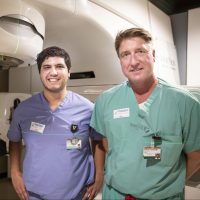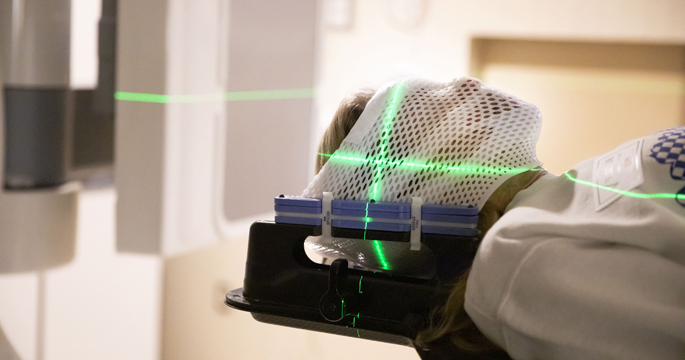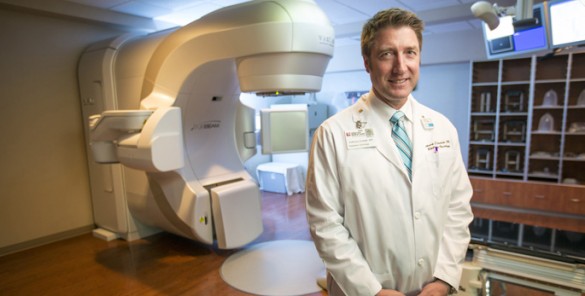
The first-ever non-invasive radiation treatment for treatment-resistant depression has greatly improved a patient’s symptoms and quality of life. This treatment was pioneered by Mohamed Khattab, MD, chief resident of Radiation Oncology, and his mentor Anthony Cmelak, MD, professor of Radiation Oncology.
Khattab, with his prior experience as a neurosurgery resident, was interested in finding new applications for radiation for patients, and he found an ideal mentor in Cmelak, an internationally recognized expert in stereotactic radiosurgery (SRS) who shared his passion for expanding the use of SRS. Leveraging his neurosurgery background, Khattab developed the idea of treating patients with neuropsychiatric diseases, including treatment-resistant depression and obsessive compulsive disorder with SRS. Together with Cmelak, they assembled the large team needed to successfully deliver this type of treatment.
Khattab and his close mentor Cmelak, collaborating with Sarah Bick, MD, assistant professor of Neurological Surgery, and William Petrie, MD, professor of Clinical Psychiatry and Behavioral Sciences, have previously used this technique to treat patients with obsessive-compulsive disorder (OCD), but this is the first known instance of the procedure being used effectively to treat major depressive disorder (MDD).
The technique, known as functional radiosurgery, uses a linear accelerator and concentrated X-ray beams with submillimeter accuracy to target the anterior limb of the internal capsule — part of the brain circuit that, when interrupted, can treat treatment-resistant depression. Since the procedure is entirely incisionless, there is no risk of bleeding or infection of the brain, and there is no down time necessary afterwards. The procedure is also frameless, using a thermoplastic mask to hold a patient’s head still instead of a halo secured by skull pins.
“Functional radiosurgery allows us to restore or improve a patient’s neurologic or psychiatric function by purposefully targeting areas in the brain using focused X-rays instead of open surgery,” Khattab explained. “Using this noninvasive strategy, we have previously treated many patients with tremor, pain syndromes, epilepsy, OCD and now MDD safely and effectively.”
Khattab says MDD is very common around the world, with 10 to 30% of patients being classified as treatment resistant. Interventions for treatment-resistant cases commonly include intravenous medications — such as tranquilizers — deep brain stimulation, radiofrequency ablation and electroconvulsive therapy, all considered invasive with the potential to bring about side effects.
This patient’s procedure was designed and performed by a collaborative team including Cmelak, Khattab and radiation physicist Guozhen Luo, MS, with Bick confirming the placement of the radiosurgery targets in her brain and Petrie confirming that her mental illness was severe enough to benefit from functional radiosurgery, as well as measuring psychologic improvements after treatment.
The patient, who wishes to remain anonymous, had experienced major depression for more than 50 years, with frequent instances of suicidal ideation. She previously tried many anti-depressants and transcranial magnetic stimulation with no success. Prior to her procedure she was receiving bi-monthly ketamine infusions, which caused rapid improvement for her symptoms, but with effects that wore off quickly.
The patient started feeling a change in her mental health around a month after her radiosurgery procedure. Now, four months out, she no longer needs ketamine infusions and has no thoughts of suicide. “It’s like my depression is just over. I have normal days — if I’m tired, it’s just because I didn’t sleep well. If I’m sad, it’s just because something sad happened. I’m not ruled by this constant feeling of misery anymore — I don’t feel depressed.”
A serious life challenge after her treatment, the loss of one of her closest friends, showed an additional clinical benefit to the treatment: for the first time in decades, she found that she was able to properly mourn such a loss. Before the procedure, she was unable to feel many emotions at all. But now she was able to feel sadness and cry. As a result, she began the process of moving forward and healing, recognizing that what she was feeling was part of the normal human experience.
“Our treatment didn’t interrupt her normal grieving,” Khattab said. “It shows that this treatment relieves depression without interfering with normal human moments of sadness and grieving. It is inspiring to see patients like her, after experiencing depression for so many years, now finally able to enjoy their lives, pursue their hobbies, and process the tough moments in life in a healthy way.”
The patient is living a rejuvenated life, experiencing adulthood without depression looming over her for the first time ever. As a retiree, she says she is looking forward to doing whatever she wants. “Today I went for a walk, I worked in the yard and did normal ‘retirement’ things. Previously, I wasn’t really able to do anything,” she said.
The small joys are on par with the big joys for her. She has rediscovered her love of sunsets, traveling and reading, and recently concentrated well enough to read two books. She had not been able to do that for many years prior to her procedure.
“I would say I have a pretty positive outlook. I can focus, concentrate and get out in the world,” the patient said. “I’m not in the hole of depression anymore.”
Cmelak believes this procedure can be life changing for thousands of patients who suffer from refractory depression, and given the number of facilities that can perform high-level radiosurgery, may allow future implementation within driving distance of most patients’ homes once the clinical trial has accrued and results have matured.
Khattab is the principal investigator of a clinical trial (NCT04688554) which follows patients who have undergone radiosurgery for neuropsychiatric and other functional diseases.
Cmelak and Khattab are actively accepting referrals for radiosurgery procedures for neuropsychiatric diseases, including MDD. Khattab will be treating patients at Minneapolis Radiation Oncology starting in August, while Cmelak will continue to see patients at Vanderbilt; the two are excited to continue this collaboration across multiple institutions. For more information call (615) 322-2555 or visit vumc.org/radiation-oncology/.















